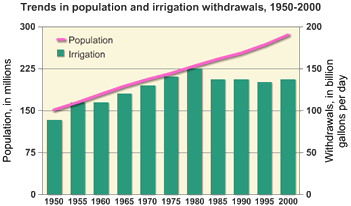Agricultural Water
What is agricultural water?
Agricultural water is water that is used to grow fresh produce and sustain livestock. The use of agricultural water makes it possible to grow fruits and vegetables and raise livestock, which is a main part of our diet. Agricultural water is used for irrigation, pesticide and fertilizer applications, crop cooling (for example, light irrigation), and frost control. According to the United States Geological Survey (USGS), water used for irrigation accounts for nearly 65 percent of the world’s freshwater withdrawals excluding thermoelectric power (1). There are 330 million acres of land used for agricultural purposes in the United States that produce an abundance of food and other products (2).

Figure courtesy of USGS
When agricultural water is used effectively and safely, production and crop yield are positively affected. A decrease in applied water can cause production and yield to decrease. Management strategies are the most important way to improve agricultural water use and maintain optimal production and yield. The key is to implement management strategies that improve water use efficiency without decreasing yield. Some examples include improved irrigation scheduling and crop specific irrigation management. These strategies allow for the conservation of water and energy, and decrease grower’s costs (3).
Why should I be concerned about the agricultural water quality in my area?
Water quality can be affected by poor planning of industrial sites, animal farms, and barnyards and feedlots. Until recently, the type of water source has been indicative of the potential risks of contamination. Poor water quality can affect the quality of food crops and lead to illness in those who consume them. For example, the water may contain germs that cause human disease. Irrigating crops with contaminated water can then lead to contaminated food products which lead to illness when eaten. Groundwater, for example, has been considered one of the safest sources of water. However, depending on field location and field size, it may not be possible to use water from these sources for irrigation.
Where does agricultural water come from?

Figure courtesy of USGS
Agricultural water comes from a variety of sources. Typical sources of agricultural water include:
- Surface water
- Rivers, streams, and irrigation ditches
- Open canals
- Impounded water such as ponds, reservoirs, and lakes
- Groundwater from wells
- Rainwater
- Locally collected water such as cisterns and rain barrels
Municipal water systems such as city and rural water can also be used for agricultural purposes.
References
- U.S. Geological Survey. Estimated Use of Water in the US in 2000. Available at http://pubs.usgs.gov/circ/2004/circ1268/htdocs/text-ir.html.
- Environmental Protection Agency. Protecting Water Quality from Agricultural Runoff: Clean Water is Everybody’s Business. Nonpoint Source Control Branch, 2005.
- California Department of Water Resources. Agricultural Use Program: California’s Irrigated Agriculture. Available at http://www.owue.water.ca.gov/agdev/.
- Page last reviewed: October 11, 2016
- Page last updated: October 11, 2016
- Content source:


 ShareCompartir
ShareCompartir